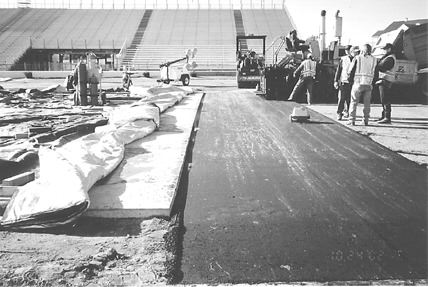The full-throttle roar of engines and rowdy fans have not been heard since late October at the Brainerd International Raceway (BIR) in north-central Minnesota, but not all is silent. More than 600 tons of taconite in asphalt have been trucked to the 510-hectare facility to help build what is hoped will be one of the finest and fastest drag racing strips in North America.
Under 100 massive thermal tarps, contractors and engineers have reconstructed a quarter-mile, 2-piece drag strip. The first piece is a concrete slab measuring 66 ft. wide and 750 ft. long. The slab was made from one continuous pour of concrete, and contractors used machines and tools equipped with lasers to ensure a flatness factor of 98. In other words, the difference between any two spots on the concrete part of the track is less than the thickness of a piece of paper.
The only drag strip flatter than BIR is the Pomona Raceway in California, with a flatness factor of 104.
When racers reach half-track at BIR and run out of concrete, they can thank taconite for the smooth transition to the next 750 ft. of asphalt.
Taconite tailings are widely available in northern Minnesota and often used in the construction of public roadways employing asphalt. Taconite in asphalt provides a more dense mixture than traditional rock aggregate, thus ensuring a more durable, even surface. On the racetrack, the use of taconite in asphalt creates a consistency similar to that of concrete, making the transition from cement to asphalt smoother, and cheaper. In fact, it would have cost Brainerd International Raceway about US$250,000 to make the entire track out of concrete, whereas taconite sells for about US95 per ton.
“After doing some research on the use of taconite in asphalt, we decided it was a good dense alternative to common rock aggregate,” says BIR General Manager Scott Quick. “We looked at several public roadways that had taconite used in the asphalt mix and did not see the extensive lateral cracking that you would see [in asphalt using rock aggregate].”
For racers, the use of taconite guarantees higher speeds by making the surface slightly more gummy than traditional asphalt, thereby giving giant racing tires more grip and drivers more control.
This is how the track is ideally suited for racing. Drag cars have two gears, and drivers shift twice as they move down the track: once at the start line, and again at half track, or the eighth-mile mark. At that point, a 4,500-kw (6,000-hp) nitromethane-burning engine (in the high-end cars) still has the wheels spinning until the driver drops the rig into second gear and receives a burst of speed — often in excess of 460 km per hour in the elite series.
When races are often decided by one-thousandth of a second, even the slightest bump can mean the difference between being at the top of the podium and finishing out of contention. The 41-year-old Quick describes the transition from concrete to taconite asphalt at BIR as “ever so slight.”
The 6-year general manager hopes the efforts of the crew at BIR will pay off in world-record times at the new track.
“Given the right atmospheric conditions and temperature, it’s likely we’ll set some world records,” predicts Quick.
The raceway, now in its 34th season, hosts 13 races each year. Racers will get their first chance try the new strip at a sportsman series race slated for May 10.


Be the first to comment on "Taconite helps make raceway safer and faster"